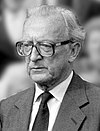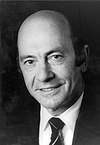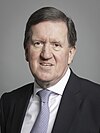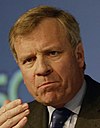Secretary General of NATO
| Secretary General of the North Atlantic Treaty Organization | |
|---|---|
| Secrétaire général de l'OTAN (French) | |
 Logo of NATO | |
 | |
since 1 October 2024 | |
| North Atlantic Treaty Organization | |
| Type | |
| Member of | North Atlantic Council |
| Seat | NATO headquarters |
| Appointer | Member states |
| Term length | Four years, renewable |
| Formation | 24 March 1952 |
| First holder | Hastings Ismay, 1st Baron Ismay |
| Deputy | Deputy Secretary General |
| Website | Office of the Secretary General |
The secretary general of NATO is the chief civil servant of the North Atlantic Treaty Organization (NATO), an intergovernmental military alliance with 32 member states. The officeholder is an international diplomat responsible for coordinating the workings of the alliance, leading NATO's international staff, chairing the meetings of the North Atlantic Council and most major committees of the alliance, with the notable exception of the NATO Military Committee, as well as acting as NATO's spokesperson.[1] The secretary general does not have a military command role; political, military and strategic decisions ultimately rest with the member states. Together with the chair of the NATO Military Committee and the supreme allied commander, the officeholder is one of the foremost officials of NATO.
The current secretary general is former Dutch prime minister Mark Rutte, who took office on 1 October 2024.[2]
History
[edit]Article 9 of the North Atlantic Treaty requires NATO members to "establish a Council, on which each of them shall be represented."[3] Accordingly, the North Atlantic Council was formed. Initially the Council consisted of NATO members' foreign ministers and met annually.[4] In May 1950, the desire for closer coordination on a day-to-day basis led to the appointment of Council deputies, permanently based in London and overseeing the workings of the organization. Deputies were given full decision-making authority within the North Atlantic Council, but their work was supplemented by occasional meetings of the NATO foreign ministers.[5] The chairman of the deputies was given responsibility "for directing the organization and its work," including all of its civilian agencies.[6]
The Council deputies met for the first time on July 25, 1950, and selected Charles Spofford, the United States deputy, as their chairman.[7] Several important organisational changes quickly followed the establishment of Council deputies, most notably the establishment of a unified military command under a single supreme allied commander.[8] This unification and the growing challenges facing NATO led to rapid growth in the institutions of the organisation and in 1951, NATO was reorganized to streamline and centralize its bureaucracy. As part of the organization, the Council deputies were delegated with the authority to represent their governments in all matters, including those related to defense and finance, not just foreign affairs, greatly increasing their power and importance.[9]
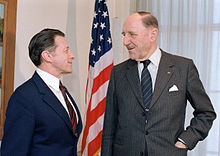
As the authority of the deputies increased, and the size of the organization grew, NATO established the Temporary Council Committee, chaired by W. Averell Harriman. This group established an official secretariat in Paris to command NATO's bureaucracy.[10] The committee also recommended that "the agencies of NATO needed to be strengthened and co-ordinate", and emphasized the need for someone other than the chairman of the North Atlantic Council to become the senior leader of the alliance.[11] In February 1952, North Atlantic Council accordingly established the position of secretary general to manage all civilian agencies of the organization, control its civilian staff, and serve the North Atlantic Council.[12]

After the Lisbon Conference, the NATO states began looking for a person who could fill the role of secretary general. The position was first offered to Oliver Franks, the British ambassador to the United States, but he declined. Then, on March 12, 1952, the North Atlantic Council selected Hastings Ismay, a general from the Second World War, and secretary of state for commonwealth relations in the British cabinet as secretary general.[13] Unlike later secretaries general who served as chairman of the North Atlantic Council, Ismay was made the vice chairman of the council, with Spofford continuing to serve as chairman. Ismay was selected because of his high rank in the war, and his role "at the side of Churchill ... in the highest Allied Councils." As both a soldier and a diplomat, he was considered uniquely qualified for the position, and enjoyed the full support of all the NATO states.[14] Several months later, after Spofford retired from NATO, the structure of the North Atlantic Council was changed slightly. One member of the council was selected annually as the president of the North Atlantic Council (a largely ceremonial role), and the secretary general officially became the deputy president of the council, as well as the chair of its meetings.[15] Ismay served as secretary general until retiring in May, 1957.[16]

After Ismay, Paul-Henri Spaak, an international diplomat and former prime minister of Belgium, was selected as the second secretary general. Unlike Ismay, Spaak had no military experience, so his appointment represented a "deemphasis of the strictly military side of the Atlantic Alliance."[17] When confirming Spaak's appointment in December 1956 during a session of the NATO foreign ministers, the North Atlantic Council also expanded the role of the secretary general in the organization. Largely as a result of the Suez Crisis, which had strained intra-alliance relations, the council issued a resolution to allow the secretary general "to offer his good offices informally at any time to member governments involved in a dispute and with their consent to initiate or facilitate procedures of inquiry, mediation, conciliation, or arbitration."[18]
List of officeholders
[edit]The NATO countries selected the first secretary general on 4 April 1952. Since that time, twelve different diplomats have served officially as secretary general. Eight countries have been represented, with three secretaries general hailing from the United Kingdom, four from the Netherlands, two from Belgium, one from Italy, one from Germany, one from Spain, one from Denmark and one from Norway. The position has also been occupied temporarily on three occasions by an acting secretary general between appointments.
| No. | Portrait | Secretary General | Took office | Left office | Time in office | Previous office | Country of origin |
|---|---|---|---|---|---|---|---|
| 1 | General Hastings Ismay 1st Baron Ismay (1887–1965) | 24 March 1952 | 16 May 1957 | 5 years, 53 days | Secretary of State for Commonwealth Relations | ||
| 2 | Paul-Henri Spaak (1899–1972) | 16 May 1957 | 21 April 1961 | 3 years, 340 days | Prime Minister of Belgium | ||
| 3 | Dirk Stikker (1897–1979) [a] | 21 April 1961 | 1 August 1964 | 3 years, 102 days | Minister of Foreign Affairs | ||
| 4 | Manlio Brosio (1897–1980) | 1 August 1964 | 1 October 1971 | 7 years, 61 days | Ambassador to the United Kingdom | ||
| 5 | Joseph Luns (1911–2002) | 1 October 1971 | 25 June 1984 | 12 years, 268 days | Minister of Foreign Affairs | ||
| 6 | Peter Carington 6th Baron Carrington (1919–2018) | 25 June 1984 | 1 July 1988 | 4 years, 6 days | Secretary of State for Foreign and Commonwealth Affairs | ||
| 7 | Manfred Wörner (1934–1994) [b] | 1 July 1988 | 13 August 1994 † | 6 years, 43 days | Minister of Defence | ||
| – | Sergio Balanzino (1934–2018) Acting | 13 August 1994 | 17 October 1994 | 65 days | Deputy Secretary General of NATO | ||
| 8 | Willy Claes (born 1938) [c] | 17 October 1994 | 20 October 1995 | 1 year, 3 days | Minister of Foreign Affairs | ||
| – | Sergio Balanzino (1934–2018) Acting | 20 October 1995 | 5 December 1995 | 46 days | Deputy Secretary General of NATO | ||
| 9 | Javier Solana (born 1942) | 5 December 1995 | 14 October 1999 | 3 years, 313 days | Minister of Foreign Affairs | ||
| 10 | George Robertson Baron Robertson of Port Ellen (born 1946) [d] | 14 October 1999 | 17 December 2003 | 4 years, 64 days | Secretary of State for Defence | ||
| – | Alessandro Minuto-Rizzo (born 1940) Acting | 17 December 2003 | 1 January 2004 | 15 days | Deputy Secretary General of NATO | ||
| 11 | Jaap de Hoop Scheffer (born 1948) [e] | 1 January 2004 | 1 August 2009 | 5 years, 212 days | Minister of Foreign Affairs | ||
| 12 | Anders Fogh Rasmussen (born 1953) | 1 August 2009 | 1 October 2014 | 5 years, 61 days | Prime Minister of Denmark | ||
| 13 | Jens Stoltenberg (born 1959) | 1 October 2014 | 1 October 2024 | 10 years, 0 days | Prime Minister of Norway | ||
| 14 | Mark Rutte (born 1967) | 1 October 2024 | Incumbent | 101 days | Prime Minister of the Netherlands |
Responsibilities
[edit]The NATO secretary general chairs several of the senior decision-making bodies of NATO. In addition to the North Atlantic Council, he chairs the Defence Planning Committee and the Nuclear Planning Committee, two of NATO's important military organizations. The secretary general also leads the Euro-Atlantic Partnership Council, the Mediterranean Cooperation Group, and serves as joint chairman of the Permanent Joint Council and the NATO-Ukraine Commission.
In a second role, the secretary general leads the staff of NATO. He directs the international staff of the organization, and the Office of the Secretary General. The secretary general also directs his or her own private office. All of these bodies draw personnel from all members of NATO, so the secretary general must carefully coordinate.[27] For assistance in his responsibilities, the secretary general also has a deputy appointed by the organization.
Selection
[edit]There is no formal process for selecting the secretary general. The members of NATO traditionally reach a consensus on who should serve next. This procedure often takes place through informal diplomatic channels, but it still can become contentious. For example, in 2009, controversy arose over the choice of Anders Fogh Rasmussen as secretary general, due to opposition from Turkey.[28]
NATO's chief military officer, the supreme allied commander Europe, is traditionally an American, and the secretary general has traditionally been a European. However, there is nothing in NATO's charter that would preclude a Canadian or American from becoming the secretary general.[29]
Deputy Secretary General
[edit]| # | Name | Country | Duration |
|---|---|---|---|
| 1 | Jonkheer van Vredenburch | 1952–1956 | |
| 2 | Baron Adolph Bentinck | 1956–1958 | |
| 3 | Alberico Casardi | 1958–1962 | |
| 4 | Guido Colonna di Paliano | 1962–1964 | |
| 5 | James A. Roberts | 1964–1968 | |
| 6 | Osman Esim Olcay | 1969–1971 | |
| 7 | Paolo Pansa Cedronio | 1971–1978 | |
| 8 | Rinaldo Petrignani | 1978–1981 | |
| 9 | Eric da Rin | 1981–1985 | |
| 10 | Marcello Guidi | 1985–1989 | |
| 11 | Amedeo de Franchis | 1989–1994 | |
| 12 | Sergio Balanzino | 1994–2001 | |
| 13 | Alessandro Minuto Rizzo | 2001–2007 | |
| 14 | Claudio Bisogniero | 2007–2012 | |
| 15 | Alexander Vershbow | 2012–2016 | |
| 16 | Rose Gottemoeller | 2016–2019 | |
| 17 | Mircea Geoană | 2019–2024 | |
| 18 | Radmila Šekerinska | 2024– |
See also
[edit]- Supreme Allied Commander Europe
- Chairman of the NATO Military Committee
- Secretary General of the CSTO – Collective Security Treaty Organization (CSTO) equivalent
Notes
[edit]- ^ Stikker resigned from his position a year early due to poor health.[19]
- ^ Wörner died in office on 13 August 1994 of cancer. The Deputy Secretary General, Sergio Balanzino, took over his daily responsibilities for the last several months of his life and then became acting Secretary General upon his death until the appointment of Willy Claes.[20]
- ^ Claes resigned as Secretary General after a bribery scandal, centering on his actions in the Belgian cabinet in the 1980s. After his resignation, Deputy Secretary General Sergio Balanzino served as acting Secretary General until the appointment of Javier Solana.[21]
- ^ George Robertson announced in January 2003 that he would be stepping down in December.[22] Jaap de Hoop Scheffer was selected as his successor, but could not assume the office until January 2004 because of his commitment in the Dutch Parliament.[23] Robertson was asked to extend his term until Scheffer was ready, but declined, so Minuto-Rizzo, the Deputy Secretary General, took over in the interim.
- ^ Scheffer was named Secretary General of NATO effective 1 January 2004,[24] but he did not take office until 5 January 2004.[25][26]
Citations
[edit]- ^ NATO Secretary General, NATO.
- ^ Foy, Henry (2024-06-20). "Mark Rutte clears last hurdle for Nato top job". Financial Times. Retrieved 2024-10-01.
- ^ "The North Atlantic Treaty".
- ^ Ismay, Lord. "NATO-The first 5 years 1949-1954". p. 24.
- ^ Ismay, p. 28
- ^ "15th - 18th May: London". NATO Final Communiques 1949-1974. NATO Information Service. p. 56.
- ^ Ismay, p. 31
- ^ Ismay, p. 37
- ^ Ismay, p. 41
- ^ Ismay, p.44
- ^ Ismay, p.46
- ^ Ismay, p. 48
- ^ "Resolution on the Appointement of Lord Ismay".
- ^ Daniel, Clifton (March 13, 1952). "Ismay Named Civilian Chief of Atlantic Pact Organization". The New York Times.
- ^ Fedder, p. 10
- ^ Brosio, p. 39
- ^ "Spaak for Ismay". The Washington Post. December 16, 1956.
- ^ "11th-14th December: Paris". NATO Final Communiques 1949-1974. NATO Information Service. p. 104.
- ^ Cook, Don (3 April 1964). "Resignation announced by Stikker". The Washington Post.
- ^ Marshall, Andrew (15 August 1994). "Hunt is on to find new Nato chief". The Independent. London. Retrieved 2009-03-29.
- ^ Whitney, Craig (21 October 1995). "Facing Charges, NATO Head Steps Down". The New York Times. Retrieved 2009-03-29.
- ^ Smith, Craig (23 January 2003). "NATO Secretary General to Leave His Post in December After 4 Years". The New York Times. Retrieved 2009-03-29.
- ^ "Jaap de Hoop Scheffer". Newsmakers. No. 1. Thomson Gale. 1 January 2005.
- ^ Crouch, Gregory (23 September 2003). "NATO Names a Dutchman To Be Its Secretary General". The New York Times. Retrieved 2009-03-29.
- ^ "NATO Chief Steps Down". The New York Times. 18 December 2003. Retrieved 2009-03-29.
- ^ Crouch, Gregory (6 January 2004). "New NATO Chief Takes Over". The New York Times. Retrieved 2009-03-29.
- ^ "Civilian Organisation and Structures: The Secretary General". www.nato.int.
- ^ Kardas, Saban. "Ankara Debates Rasmussen's Candidacy for NATO Secretary-General". The Jamestown Foundation.
- ^ "NATO Secretary General: How is he or she selected and for how long".
- ^ "NATO Who's who? – Deputy Secretaries General of NATO". NATO. Retrieved 20 July 2012.
References
[edit]- Brosio, Manlio (1969). NATO: Facts and Figures. NATO Information Service.
- Ismay, Hastings (1954). NATO: The First Five Years. NATO.
- Fedder, Edwin (1973). NATO:The Dynamics of the Alliance in the Postwar World. Dodd, Mead & Company. ISBN 0-396-06621-6.
- "Fonds. NATO Secretary General". NATO.
External links
[edit] Media related to NATO Secretaries General at Wikimedia Commons
Media related to NATO Secretaries General at Wikimedia Commons- Official website







